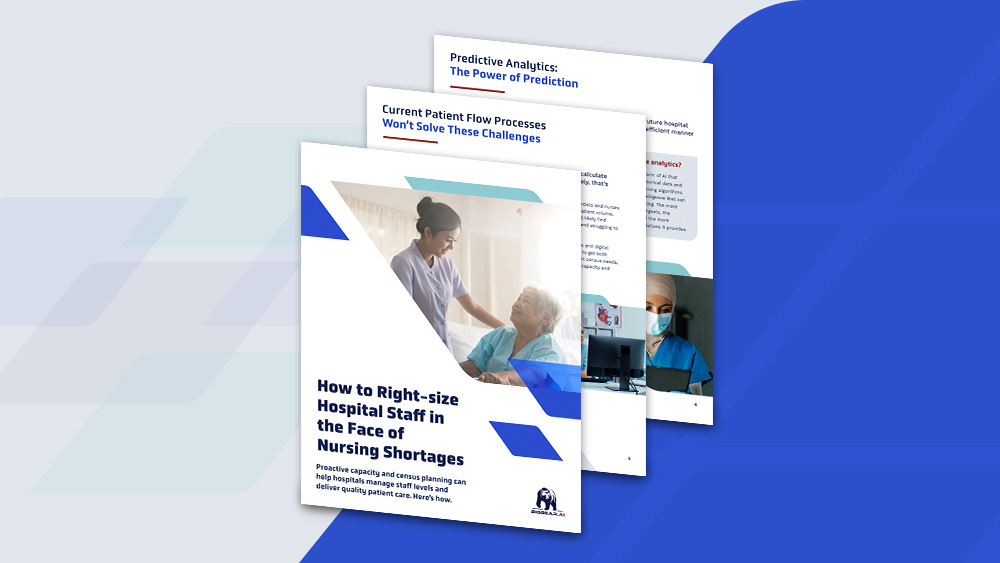How Hospitals Can Use Predictive Analytics and Digital Twins to Improve Surge Plan Modeling
 Predictive analytics and digital twins can help hospitals plan for the most likely scenarios, while also preparing for the worst ones
Predictive analytics and digital twins can help hospitals plan for the most likely scenarios, while also preparing for the worst ones
When the COVID-19 pandemic emerged, hospitals were faced with a surge that no one predicted—and thus no one was prepared for. Many hospitals were operating at more than 90% adult intake occupancy and struggled to balance COVID treatment with routine care. Hospitals didn’t have the beds or equipment needed and were forced to create makeshift ICU units.
While hopefully the worst of the pandemic is behind us, the prospect of future surges remains high. This winter, for instance, a surge is likely due to the combination of COVID and the flu, or other respiratory illnesses.
Hospitals need to be prepared. The best way to do this is through surge planning, which can help hospitals manage not just major epidemics, but also one-off census spikes and seasonal trends. To effectively manage surges, flexibility is key.
Four components of surge planning
Experts have outlined four components of surge planning as:
- Space: A hospital’s ability to manage a surge isn’t just bed space
- Staff: A particularly high concern with many nurses leaving the profession
- Stuff: Refers to supplies
- Systems: Refers to coordination, whether diverting low-risk patients or converting units to handle the surge at hand
To ensure top-notch care, hospitals need contingency plans for various surge levels and types and for overall healthcare operations improvement. Data-driven decision tools like predictive analytics and digital twins can help hospitals gain more predictability and efficiency in their surge plan modeling.
Predictive analytics: modeling the surge
Surges come in many forms. In the summer, children’s hospitals often deal with an influx of orthopedic cases, as kids are more likely to break bones playing outside. In the colder months, they tend to face large spikes in respiratory syncytial viruses (RSVs). Being able to plan for such surges is crucial to properly maximizing resources and personnel.
 Predictive analytics—a form of AI that continuously takes raw, historical data and applies it to machine learning algorithms—can help hospital decision-makers forecast and plan for surges more accurately and efficiently than ever before. Discrete-event simulation (DES), for example, can predict patients’ lengths of stays and movements through a hospital based on medical data from previous similar patients—key information for understanding future capacity.
Predictive analytics—a form of AI that continuously takes raw, historical data and applies it to machine learning algorithms—can help hospital decision-makers forecast and plan for surges more accurately and efficiently than ever before. Discrete-event simulation (DES), for example, can predict patients’ lengths of stays and movements through a hospital based on medical data from previous similar patients—key information for understanding future capacity.
Predictive analytics can also be applied to What If Scenario Analysis (WISA), which uses anonymized historical data to model various surges. WISA analysis can be used to plan for likely, worst-case, and “everything in between” possibilities. The more information the system ingests, the smarter it becomes—and the more accurate the scenarios it provides.
All these tools can help hospitals fine tune their surge plans, ensuring they have the right number of beds and capacity to accommodate new and existing patients, as well as the right number of staff.
Digital twins: modeling the response
Digital twins can take surge planning to the next level, offering visual representations of various surge scenarios. Digital twins are virtual replicas of a physical object or system—in this case, the hospital. By visualizing DES and WISA, digital twins can help hospital decision-makers answer questions like:
- What if the flu creates a 10% jump in our census? How do we staff accordingly?
- What if COVID-19 and the flu coincide this winter? What resources and staffing will we need?
- How long are patients staying in the hospital and how might that length of time impact surges?
- Do we have the nurses needed for our projected mix of patients?
- What units could we convert during a surge and how would that affect care?
With a digital twin, hospital decision-makers can adjust the time frame as needed to look at the short-term (hours to days), mid-term (weeks to months), and long-term (months to years, which can help in master planning). Whatever the time frame, they have the power to assess their space, staff, stuff, and systems for a wide range of scenarios and potential surges.
How to Right-size Hospital Staff in the Face of Nursing Shortages
This is crucial to surge planning—and impossible using manual or traditional methods, like Monte Carlo simulations or spreadsheets.
Altogether, accurate surge planning can keep hospitals from overplanning—which can be both costly and wasteful—while still being prepared for a massive surge. Understaffing can weigh on care, but overstaffing can weigh on budgets, particularly with contract nurses charging as much as $200 per hour. Data-driven decision tools can help hospitals find the middle ground.
The bottom line
It’s impossible to predict the future, but it’s not impossible to plan for it. Surge plan modeling can help hospitals maximize resources, right-size their staff, and adjust to ever-changing trends—whether that’s a surge in a particular seasonal virus or just a short-term spike in the hospital’s census.
Predictive analytics, DES, WISA, and digital twins are smarter and more efficient means of surge planning than old-school manual methods. Hospital decision-makers can run more scenarios, dig more deeply into their complexities, and overall be better prepared for what’s to come.
Predictive Surge Plan Modeling for your Hospital Environment – Learn more
FutureFlow Rx uses a digital twin of your hospital system to model surges and predict patient flow. Learn more about our AI software solutions for hospitals by downloading our white papers: Preparing for a Tripledemic: Resource Planning in the Face of Covid-19 / Flu / RSV and How to Right-size Hospital Staff in the Face of Nursing Shortages.


